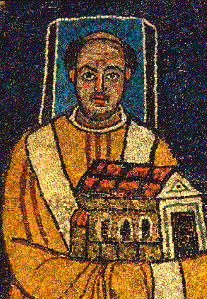– For the context of these translations click here –
Pope Paschal, who gouges out eyes and cuts off heads, is declared a saint
Why did Leo III enter the Roman martyrology in the 17th century? Why was this monstrous murderer declared a saint?
He wasn’t canonised for his brutality, nor for his liquidations, and still less for his genuflection before Charles ‘the Great’ to whom alone he owed his survival. He was canonised because at Christmas 800 he had placed the crown on Charles’ head; because he had so impressively forced the passion for domination, the never-satiated desire for supremacy of the popes; because, with that radiant sign through the ages, with that ‘trait of genius’ (de Rosa), he had inscribed once and for all in the sad book of history the aspiration of the popes for absolute leadership. This is also the reason why Franz Xaver Seppelt, the Catholic historian of the popes, sees the name of Leo III shining in the ‘catalogue of saints,’ despite all the fatalities of his long pontificate and all the corpses that litter his path: ‘Saint, saint, saint’ (his feast day, 12 June).
His successor Stephen IV, a Roman nobleman educated from boyhood at the Lateran, elected pope after ten days without consulting the emperor, ruled only a few months; but his illustrious family provided in the century two other popes.
Paschal I (817-824), Stephen’s successor, immediately had the Pactum Hludowicianum established with his predecessor confirmed by the emperor, i.e. the full extent of the promises of donation and the actual donations made by Pippin and Charlemagne, grandfather and father respectively of Louis, as well as the autonomy of the state from the Church, the papal rights of sovereignty and above all the free election of the pope.
Two of the highest papal officials, Theodore, belonging to the high nobility (and still in 821 a pope ambassador at the Frankish court) and his son-in-law the nomenclator Leo ‘because of his loyalty to Lothar’ (Astronomus); because, according to the Imperial Annals, ‘they remained loyal to the young emperor Lothar’, were blinded and beheaded by the pope’s servants in the Lateran Palace without any legal process. Everything was attributed to the pope or ‘to his approval’, says Astronomer.
Mosaic of Paschal at Santa Prassede.
The whole affair is somewhat reminiscent of the bloody proceedings of St. Leo III in 815. But in 823 the monarch also sent his judges to Rome, retiring for the rest of the summer and in the autumn to the district of Worms to hunt in the Eifel region. Paschal, however—so beloved of the Romans that at the very burial of his corpse they provoked a riot—, refused any complicity and escaped the trial, perhaps with good reason, by publicly taking the oath of cleansing in the presence of thirty-four bishops and five priests and deacons. This was a ‘means of proof’, already used by St. Leo III in December 800, and especially frequent among ecclesiastical officials. At the same time, he anathematized the murdered men as high treason, declared their death an act of justice since they had received their due as criminals of lèse majesté, and took the assassins as servants of St. Peter (of the family Sancti Petri), granting them ‘his most resolute protection’ (Annales regni Francorum).
Emperor Louis resigned himself. And Pope Paschal I died in 824 amid the family Sancti Petri. The man was cunning while Ludwig was superior and tough. When Paschal I was alive and the monks of Fulda brought him unpleasant news, he had them imprisoned without delay and threatened their abbot Mauro with excommunication. In Rome itself, they abhorred his rigorous rule which completely disrupted the state. And since not only his planned burial but also the subsequent papal election were under the sign of serious turmoil, Paschal’s body remained unburied for a long time until his successor could give him a burial, although not in St. Peter’s.
Much later, however, at the end of the 16th century, Paschal’s name managed to enter the saints’ calendar of the Catholic Church (his feast day, 14 May) through the work of the historian Caesar Baronius, an Italian cardinal of the Catholic Church.
